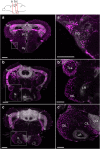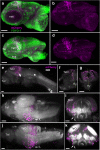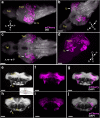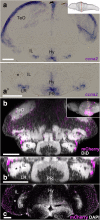Mesencephalic origin of the inferior lobe in zebrafish
- PMID: 30849972
- PMCID: PMC6407210
- DOI: 10.1186/s12915-019-0631-y
Mesencephalic origin of the inferior lobe in zebrafish
Abstract
Background: Although the overall brain organization is shared in vertebrates, there are significant differences within subregions among different groups, notably between Sarcopterygii (lobe-finned fish) and Actinopterygii (ray-finned fish). Recent comparative studies focusing on the ventricular morphology have revealed a large diversity of the hypothalamus. Here, we study the development of the inferior lobe (IL), a prominent structure forming a bump on the ventral surface of the teleost brain. Based on its position, IL has been thought to be part of the hypothalamus (therefore forebrain).
Results: Taking advantage of genetic lineage-tracing techniques in zebrafish, we reveal that cells originating from her5-expressing progenitors in the midbrain-hindbrain boundary (MHB) participate in the formation of a large part of the IL. 3D visualization demonstrated how IL develops in relation to the ventricular system. We found that IL is constituted by two developmental components: the periventricular zone of hypothalamic origin and the external zone of mesencephalic origin. The mesencephalic external zone grows progressively until adulthood by adding new cells throughout development.
Conclusion: Our results disprove a homology between the IL and the mammalian lateral hypothalamus. We suggest that the IL is likely to be involved in multimodal sensory integration rather than feeding motivation. The teleost brain is not a simpler version of the mammalian brain, and our study highlights the evolutionary plasticity of the brain which gives rise to novel structures.
Keywords: Cell lineage; Comparative neuroanatomy; Development; Evolution; Forebrain; Homology; Midbrain; Teleost; Ventricle; Vertebrate.
Conflict of interest statement
Ethics approval
All experimental protocols and care of laboratory animals were conducted in compliance with the official regulatory standards and approval of the French Government (reference document n°APAFIS#1286- 2015062616102603 v5).
Consent for publication
Not applicable.
Competing interests
The authors declare that they have no competing interests.
Publisher’s Note
Springer Nature remains neutral with regard to jurisdictional claims in published maps and institutional affiliations.
Figures










References
Publication types
MeSH terms
LinkOut - more resources
Full Text Sources
Other Literature Sources
Molecular Biology Databases

